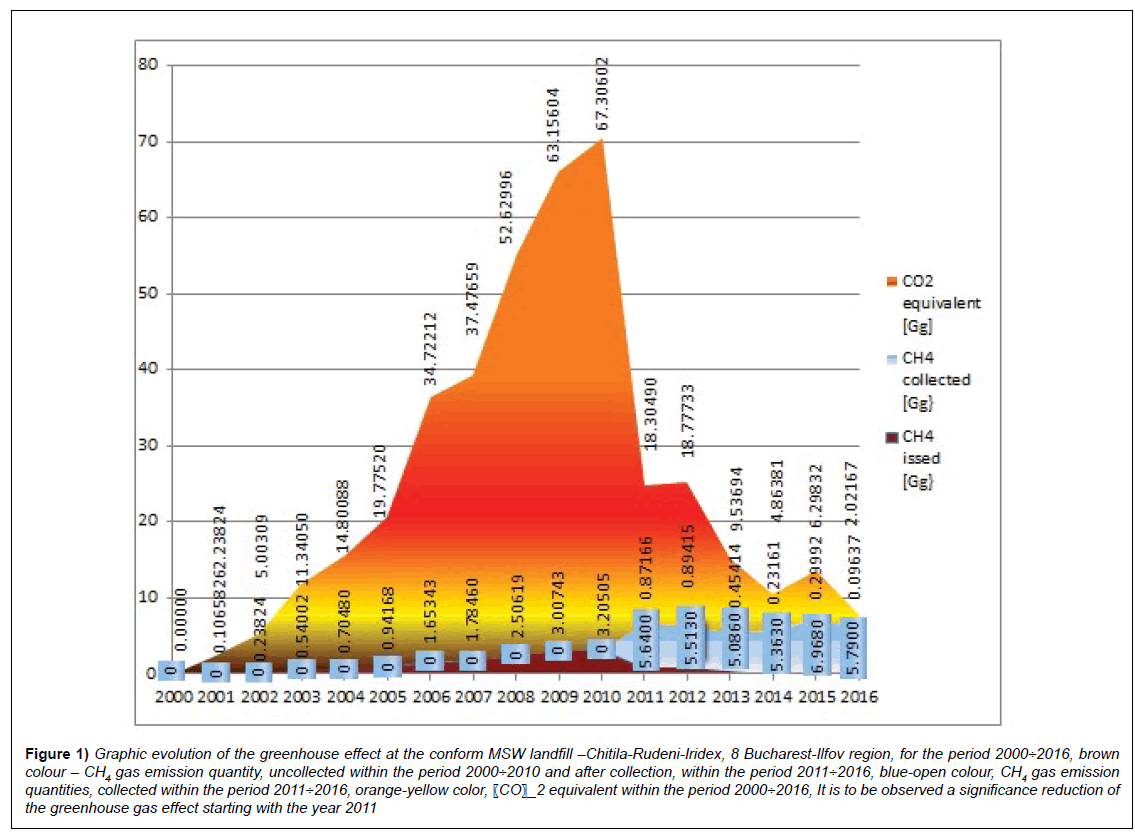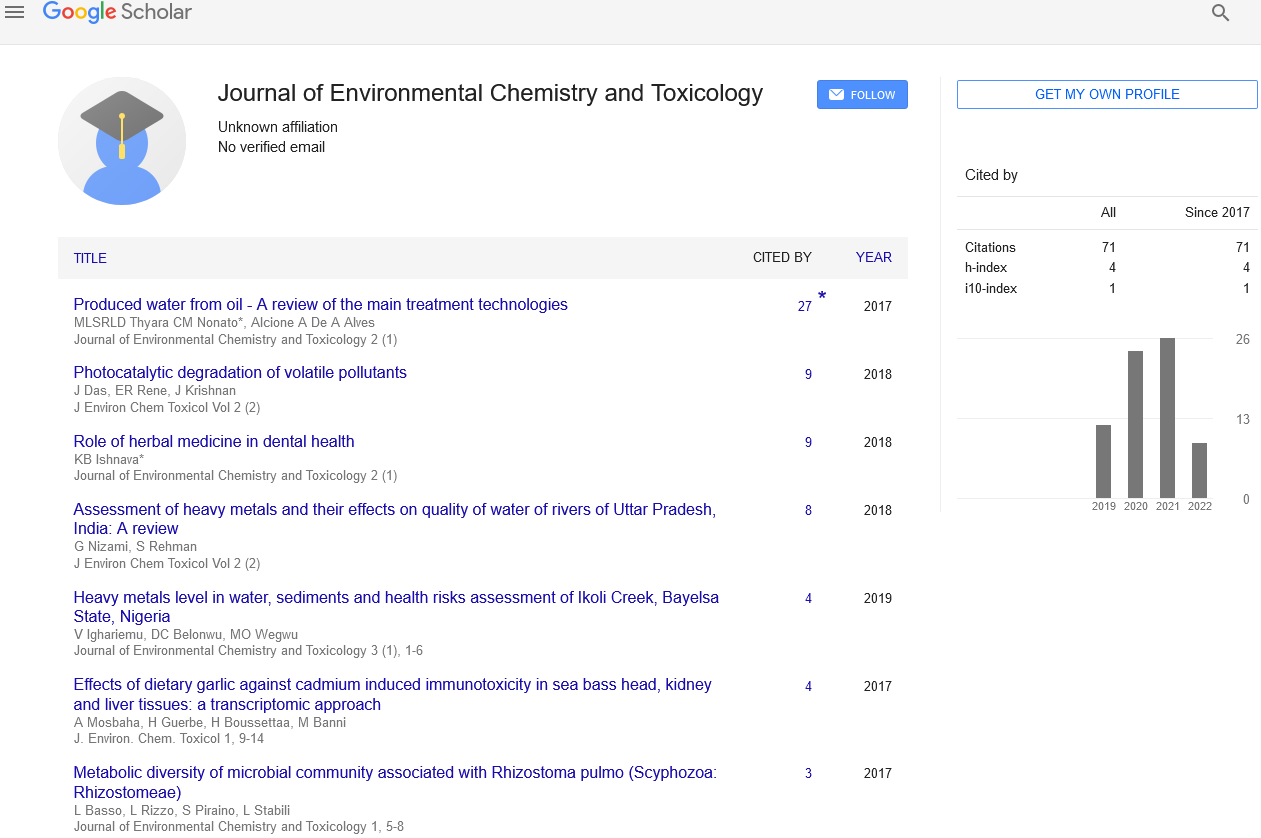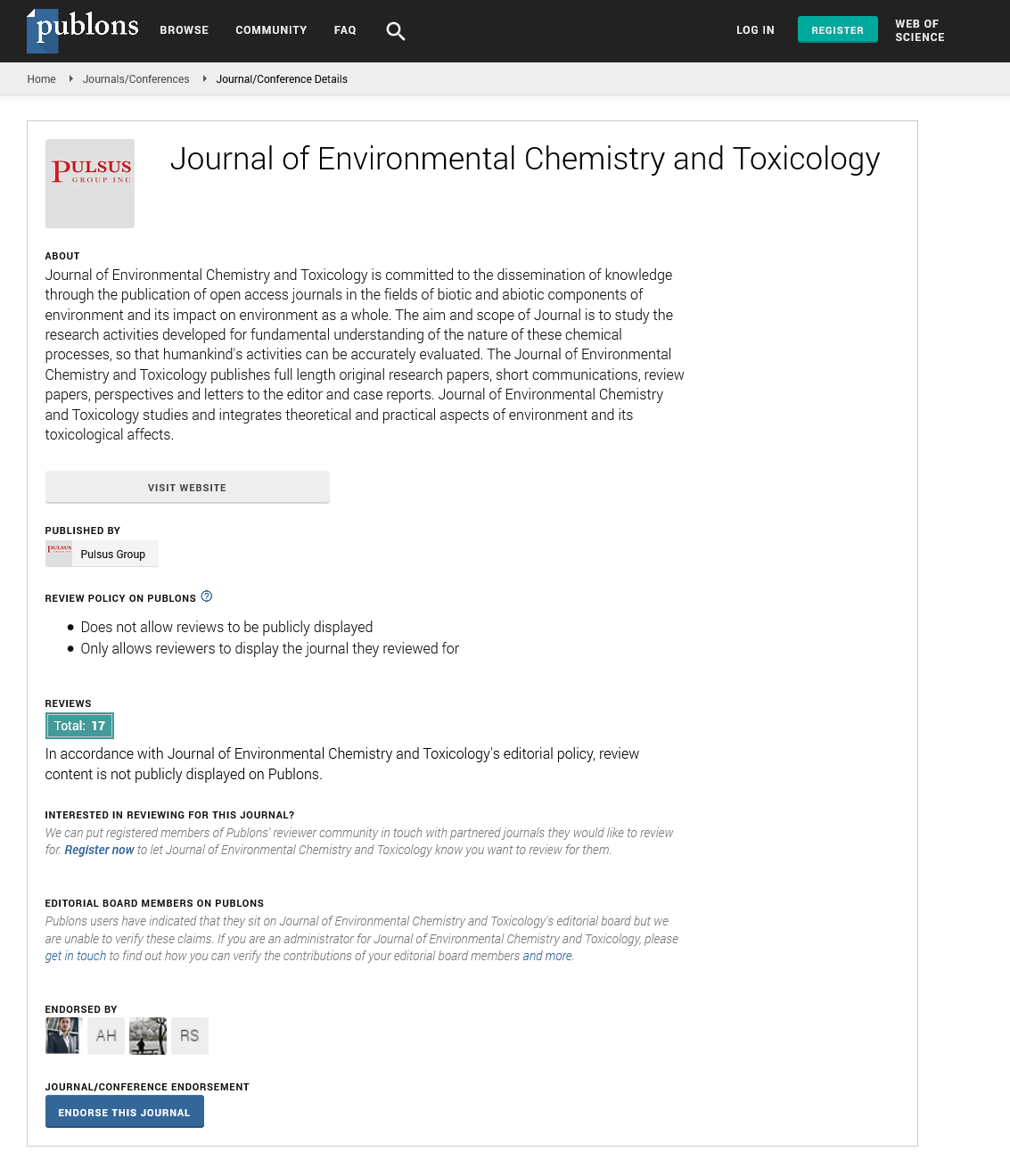A commentary on: "Nomograma of a landfill (MSW)-setting m parameter values"
Received: 27-Oct-2017 Accepted Date: Dec 01, 2017; Published: 24-Feb-2018
Citation: Vieru D. A commentary on: "Nomograma of a landfill (MSW)-setting m parameter values". J Env Chem Toxicol. 2018;2(1):20-22.
This open-access article is distributed under the terms of the Creative Commons Attribution Non-Commercial License (CC BY-NC) (http://creativecommons.org/licenses/by-nc/4.0/), which permits reuse, distribution and reproduction of the article, provided that the original work is properly cited and the reuse is restricted to noncommercial purposes. For commercial reuse, contact reprints@pulsus.com
Any type of the municipal solid wastes known as MSW (excluding the potential radioactive waste) are continuous generated and must have an increasing concern from all factors involved, such as: waste generators, economical operators belonging to the waste management, local and central authorities, all of them being involved into a friendly waste management regarding the environment. At the legitimate question: how the adequate management of the landfill (MSW) wastes will influence the climate changes is possible to answer as follows:
• Bio-degradable wastes, without economic value, have potential gas emission leading to greenhouse effect;
• Un-recyclable wastes, e.g. paper and cartoon, textile, wood and straws from garden and parks are also responsible and have a contribution to the greenhouse effect;
• The mud from used industrial water treatment plants, water connected with the house using, mud from zootehnic farms have an important contribution to the greenhouse effect gas emission generation;
• Industrial wastes (MSW) together with the wastes from medical sector have also an important potential for greenhouse effect.
It is already known that the greenhouse effect gases (6 identified gas types were identified) are dangerous for the global atmosphere heating, among them CH4 is the most dangerous one.
CH4 present a special attraction for investors, in the same time, because of its economic value [1-3].
The article: “NOMOGRAMA of a landfill (MSW)—Setting m Parameter Values” presents the analytical way for “m” parameter setting values.
When a certain quantity of deposited waste (responsible for annual CH4 gas emission quantity) is degraded this m parameter (number of months, at the calculus year) is setting up. For this reason Introduced the term “temporary mathematical equation” of a MSW deposit having the form:
3t+7=13-t
This equation is the result of the following judgment: if 7 accumulate at 3 times the time of stationing a quantity of municipal waste (MSW) on a site, the same result is obtained when a time (expressed in months -m-) of number 13 is obtained [4].
In such a way any quantity of the landfill waste deposited (MSW), conforming or non- conforming, can be approached by using the prior mathematical equation presented.
At the international level there is a mutual understanding, so that in the first year of MSW depositing on a landfill, expressed by equation:
3t+7=13-t
An incipient gas emission took place [5-7]. This emission could be expressed by formula: 3:7=0.43. So the m value is 0. After the 2nd year of depositing is over the MSW landfill deposit, the equation expressing gas emission, at every calculus year, became:
(3+8n)t+7=(12n+13)-t
From the mathematical point of view, the equation has the solution:
t=(12n+6)/(4+8n)
for every n∈N were:
t – is the equation’s “x”, t being expressed by number of months, m;
n - number of the calculus year AT
With regarding to the MSW waste degrading the information offered by the solution of the equation is incorrect [8]. The MSW waste degrading means the moment when the DOC (dissolved organic carbon) phase is reached and CH4 together with other greenhouse gas emissions are present.
It is to be noted that, in spite of the fact that currently is speaking by annual degrading, in reality, this degrading took place within a time counted in number of months, m, m ϵ N. This degrading is happened according to the environmental conditions and the m values belong to a limited interval by natural numbers,
M ϵ [7,18] or 7 ≤ m ≤ 18.
At an MSW landfill the waste depositing is happening within a calendaristic year, AC (which starts at 01.01 and ends at 31.12). The calculus year, AT related to the estimation of gas emission, is smaller with 6 months than AC (international community accepted that the waste deposited within last 6 months of the AC -31.07 ÷ 31.12- remains undegraded or with an incipient one.
The calculus year AC is the year after the calendaristic year AT of the waste (MSW) depositing is over. The equation of the first year calculation, after the 2nd year of depositing is over, is (for n=1):
11t+7=25-t.
The equation of the 2nd year calculation n =2, is 19t+7=37-t, etc.
I have to remind that 2 conditions are absolutely necessary to set-up m values (number of months), at the calculus year AT
• m ϵ [7,18] or 7 ≤ m ≤ 18, m ϵ N;

You have to pay attention to the following conditions:
• The person who is in charge for setting up NOMGRAMA of an MSW landfill has to have enough experience in the waste management field. If a computer software it will be used, there is the possibility to have a blockage it in waste management and to say that “the approaching of NOMOGRAMA setting up values is wrong”.
The m values established at the calculus year-AT have no connection with waste depositing quantities. The quantities of landfill MSW waste degraded which leads to the CH4 gas emissions are generated by the m values, at the calculus year AC. From this reason it is absolutely necessary to know the annual MSW deposited quantities. The collecting CH4 MSW deposits have to share the information to the environment authority, annually [9].
For the CH4 gas emission calculation period belonging to the calculation year 1 – AT1 and the year 8-AT8, the m parameter establishing relation is: , known as the Vieru 1 relation.
Where:
• F.T.R –free right term of the eq. 2;
• 7- a natural number which means: if 7 accumulate at 3 times the time of stationing a quantity of municipal waste (MSW) on a site, the same result is obtained when a time (expressed in months -m-) of number (12n+13) is obtained).
• for the m establishing values, starting with the 9th calculus year (eq. 2-9)
• 75t+7=121-t) up to the year 30, the following relation should be used:
• , known as Vieru 2 relation.
• Approximately approximates the value of m to the year of calculation.
• Within the Vieru 2 relation, the terms have the significance:
• F.T.R- free right term, eq. 2;
• C.t.L – t left coefficient eq.2;
7- 7- a natural number which means: if 7 accumulate at 3 times the time of stationing a quantity of municipal waste (MSW) on a site, the same result is obtained when a time (expressed in months -m-) of number ((12n)+13) is obtained.
The established calculus relation can be applied to all conform or nonconform MSW landfill deposits to capacity >10 Gg/year.
Usually the lifetime of a landfill MSW deposit not exceed 30 years. After MSW landfill waste depositing is over, the CH4 gas emission is decreasing and quits after 25 ÷ 30 years. In this case the calendaristic year-AC–is identical with the calculus year, AT, e.g. AC=AT.
The friendly environmental MSW depositing management significance
It is known that having deposits with capacity between 80÷800 Gg or more (deposits with capacity less than 80 Gg being closed), this measure will lead to the followings:
• Increasing Auto Park for wastes collecting,
• Road infrastructure improvement in order to be able to collect the waste from all locations and increasing the lifetime of the MSW waste collection trucks,
• Proper identification of the CH4 gas emission moment when it can be burned or collected,
• Adding of CH4 in significant quantities, so the investors should put in practice their projects,
• Investments within the friendly environment waste management condition will lead to new job opportunities [10].
Collection of the CH4 gas emissions, on site, for MSW landfill deposits will lead to an annually reducing of the greenhouse gas effect with a percentage of 1 ÷ 2%. This aspect will have, as a consequence, an environmental temperature reducing by minimum 1°C. Increasing of CH4 gas emission as an energetically resource, it is to be noticed, also.
Conclusion
The approach of a deposit gas emission (LFG), mainly CH4 taking into account the degraded MSW quantities, at the calculus year AC, will lead to a correct estimation of CH4 gas emission quantities
It is clear that the Vieru’s (1,2) application method for the estimation of the CH4 quantity from the Romanian MSW landfill waste deposits, conforming or nonconforming, should be an important alternative among the existing calculus relations already, on international level too.
It is to be noted that MSW deposited quantities are absolutely necessary to be known, as a common factor but the approach way has to be as follows: time, expressed in months-m- is the factor which have a decisive contribution to the MSW wastes degradation up to the DOC (dissolved organic carbon) phase.
Another example of the Vieru’s (1,2) method application related to the CH4 gas emission calculation is given in the Figure 1.
Figure 1: Graphic evolution of the greenhouse effect at the conform MSW landfill –Chitila-Rudeni-Iridex, 8 Bucharest-Ilfov region, for the period 2000÷2016, brown colour – CH4 gas emission quantity, uncollected within the period 2000÷2010 and after collection, within the period 2011÷2016, blue-open colour, CH4 gas emission quantities, collected within the period 2011÷2016, orange-yellow color, 〖CO〗_2 equivalent within the period 2000÷2016, It is to be observed a significance reduction of the greenhouse gas effect starting with the year 2011
In Table 1 the msw Chitila-Rudeni-Iridex (8 Environmental region Bucharest- Ilfov) conform deposit NOMOGRAM for the period 2000 ÷ 2016, is presented.
| Landfill (MSW) Chitila -Iridex, 8 Environmental Region-Bucharest-Ilfov | ||||||||||||||||
|---|---|---|---|---|---|---|---|---|---|---|---|---|---|---|---|---|
| Years of storage | ||||||||||||||||
| 2000 | 2001 | 2002 | 2003 | 2004 | 2005 | 2006 | 2007 | 2008 | 2009 | 2010 | 2011 | 2012 | 2013 | 2014 | 2015 | 2016 |
| Quantities of waste (MSW) stored [Gg] | ||||||||||||||||
| 43,536 | 361,157 | 361,656 | 309,421 | 349,464 | 384,451 | 367,985 | 245,497 | 448,694 | 434,852 | 425,521 | 361,000 | 371,568 | 338,340 | 306,276 | 272,554 | 310,499 |
| m [number of months], values, according Nomogram deposit | ||||||||||||||||
| 0.0 | 9.0 | 7.0 | 14.0 | 13.0 | 12.0 | 11.0 | 9.0 | 8.0 | 7.0 | 10.0 | 7.0 | 9.0 | 11.0 | 11.0 | 8.0 | 10.0 |
| CH4 [Gg]. collected | ||||||||||||||||
| 0.000 | 0.000 | 0.000 | 0.000 | 0.000 | 0.000 | 0.000 | 0.000 | 0.000 | 0.000 | 0.000 | 5.640 | 5.355 | 5.086 | 5.363 | 6.968 | 5.790 |
Table 1: Nomogram landfill (MSW) chitila -iridex, 8 environmental region, bucharest-Ilfov for the period 2000÷2016, 2000-2016, [years of storage],43,536,361,157,361,656, .....371,568,338,340.......310,499 quantities of wastes (MSW) stored [Gg], 0,0,9,0,7,0........10,0, 7,0,...11,0..8,0,10,0 m [number of months], values, according to Nomograme deposit,0,0,0,0..................5,640, ....6,988,5,790 CH4 collected, [Gg],It is to be stated that by using actual calculus relation, according to the References 7, 8, 9, it is possible to estimate CH4 gas emission quantities, but with more information data than the determination of m parameter values at the calculus year, AC . so, there are no contradictions between, these 2 approaching ways
REFERENCES
- Vieru D. Nomograma of a landfill (MSW)—setting m parameter values. Atmos Clim Sci. 2017;7:436-54.
- Vieru D. A new approach method of CH4 emission estimation from landfills. 2017.
- Mihoc G. Small mathematics encyclopedia. Technical Publishing House, Bucharest. 1980;93.
- United Nations Framework Convention on Climate Change (UNFCCC).
- KYOTO Protocol, Convention on Climate Change, Entered into Force on February, 2005, UNFCCC. 1997.
- The Doha Amendment Adopted at Doha on 8 December 2012, of the Kyoto Protocol to the United Nations Framework Convention on Climate Change Adopted on 11 December 1997. 2012.
- UN Conference on Climate Change in Paris. 2015.
- Council Directive. Landfill of Waste. 1999.
- Voicu G. The ecological solid waste depositing engineering. Politechnica Press Publishing, Bucharest Romania. 2016.
- Liu Y, Xing P, Liu J. Environmental performance evaluation of different municipal solid waste management scenarios in China. Key Laboratory for Solid Waste Management and Environment Safety, Ministry of Education of China, School of Environment. 2017.







